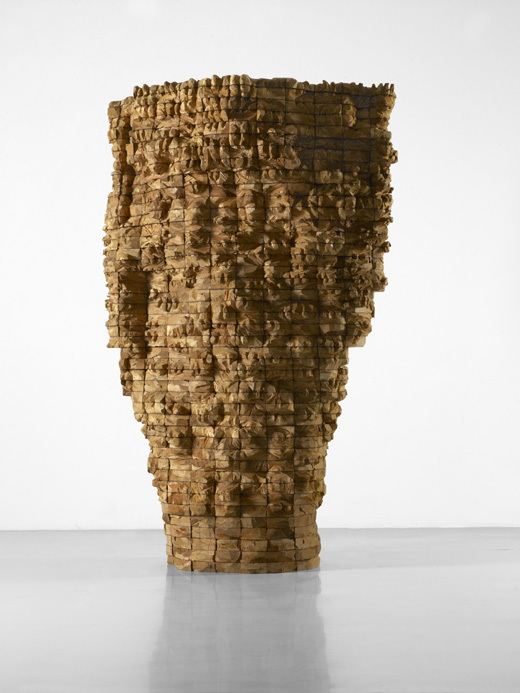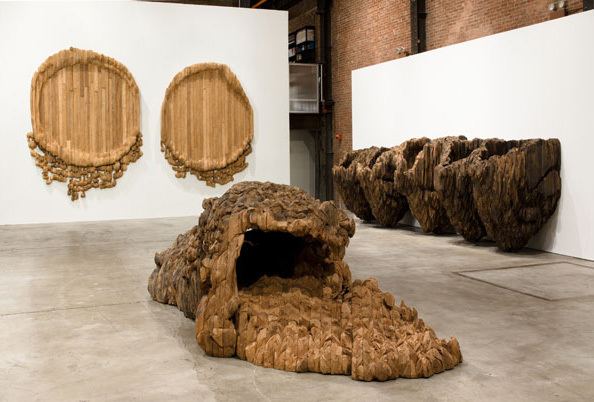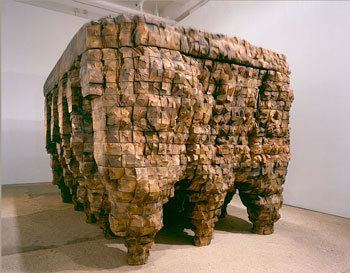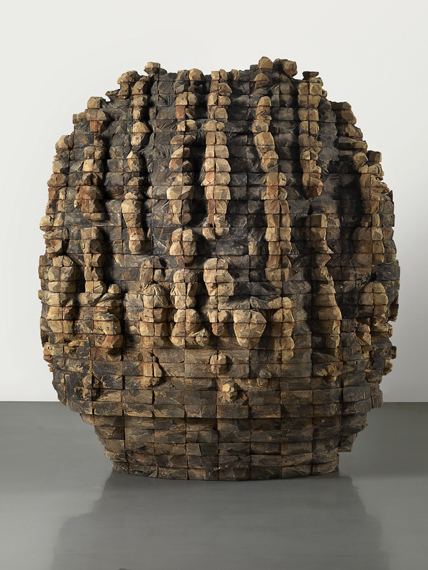Known for Sculpture Name Ursula Rydingsvard | Books Socks on My Spoons | |
 | ||
Website www.ursulavonrydingsvard.net Elected Member, American Academy of Arts and Letters Movies Art City #1: Making It In Manhattan Awards Guggenheim Fellowship for Creative Arts, US & Canada | ||
Ursula von rydingsvard becoming an artist exclusive art21
Ursula von Rydingsvard born in Deensen, Lower Saxony, then Nazi Germany, is a sculptor who has been working in Brooklyn, New York for the past 30 years. She received her MFA from Columbia University in 1975 after which time she started to work with cedar, a material through which she has explored a wide range of images.
Contents
- Ursula von rydingsvard becoming an artist exclusive art21
- Woodcuts ursula von rydingsvard
- Early life
- Achievements
- References

Von Rydingsvard is best known for creating large-scale, often monumental sculpture from the cedar beams which she painstakingly cuts, assembles, and laminates, finally rubbing powdered graphite into the work's textured, faceted surfaces. She deliberately uses cedar boards milled into 4" by 4" widths with varied lengths which create a neutrality or "blank canvas" which enables her to dip into many different possibilities often within the arena of the psychological and emotional. As von Rydingsvard explains this approach: "If I were to say how it is that I break the convention of sculpture (and I'm not sure that's what I do or even if that's what I want to do), it would be by climbing into the work in a way that’s highly personal, that I can claim as being mine. The more mine it is, the more I’m able to break the convention." Her signature abstract shapes refer to things in the real world, each revealing the mark of the human hand while also summoning natural forms and forces. These forms typically include simple vessels and bowls; many suggest tools or other artifacts such as shovels, spoons and fences, or allude to primitive dwellings, geological formations, the landscape, or the body.

Woodcuts ursula von rydingsvard
Early life

Von Rydingsvard's early years were directly affected by the upheaval of World War II. Born in Nazi Germany in 1942 to a Ukrainian father, conscripted for forced labor in that country, and a Polish mother, von Rydingsvard and her family were among the dispossessed that, after the war, were forced to move from one refugee camp for displaced Poles to another, eventually settling in the United States in 1950.

The artist's respect for organic materials and the dignity of labor, and the sense of loss and pain, and the persistent memories that inform her work may be traced back to these formative experiences. "I grew up in displaced persons camps that were barracks built by soldiers that were most expedient, the most pragmatic. It wasn’t even a lumber construction. It was plank construction that wasn’t very warm in the winters because there was no insulation. It was just me, sleeping against a plank, and on the other side of the plank was the outdoors."
Achievements
Her sculpture is included in numerous permanent collections, including the Metropolitan Museum of Art, New York; Museum of Modern Art, New York; Whitney Museum of American Art, New York; Brooklyn Museum, New York; Walker Art Center, Minneapolis; Nelson-Atkins Museum of Art, Kansas City; High Museum of Art, Atlanta, Crystal Bridges Museum of American Art, Bentonville, AR National Gallery of Art, Washington, D.C., San Francisco Museum of Modern Art, San Francisco, and Detroit Institute of Arts. Major permanent commissions of her work are on view at the Microsoft Corporation, Redmond, WA; Storm King Art Center, New York; the Bloomberg Building, New York; the Queens Family Courthouse, New York; the Nelson-Atkins, Kansas City, and the Barclays Center, Brooklyn, New York. Mad. Sq. Art: Ursula von Rydingsvard was the outdoor solo exhibition presented at Madison Square Park in 2006. She is the recipient of two individual grants from the National Endowment for the Arts, a Guggenheim Fellowship, three awards from the American section of the International Art Critics Association (Best Small Museum Exhibition 1992; Second Prize, Best Show in a Commercial Gallery 2000; Best Show in a Non-Profit Gallery or Space 2011). In 2007, she was the recipient of the Mary Miss Resident in Visual Arts Award from the American Academy in Rome. In 2008, she was inducted into the American Academy of Arts and Letters along with being featured in Art:21 Art in the Twenty-First Century on PBS. In 2014, Rydingsvard was awarded the Lifetime Achievement Award by the International Sculpture Center. A monograph on her work titled The Sculpture of Ursula von Rydingsvard was published by Hudson Hills Press in 1996 and in 2011 Prestel published Ursula von Rydingsvard: Working. In 2014-2015 Ursula von Rydingsvard had her first British show at the Yorkshire Sculpture Park (West Yorkshire, UK), her most extensive exhibition to date. The exhibition was accompanied by the Ursula von Rydingsvard 2014 Catalogue, a major publication featuring text by Molly Donovan, Curator of Modern and Contemporary Art at the National Gallery of Art in Washington. The artist is represented by Galerie Lelong, New York.
